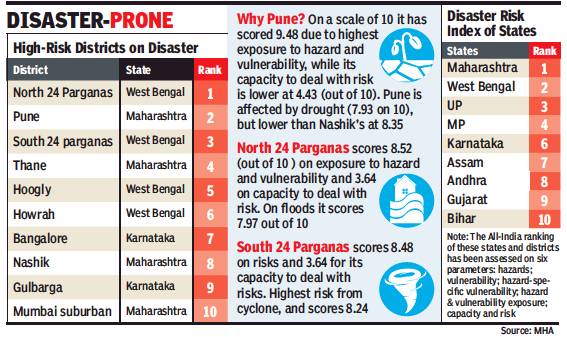Disaster risk index: India
This is a collection of articles archived for the excellence of their content. |
Contents |
India’s position in the world
2000-2019: India 3rd most disaster-prone
Pradeep Thakur, UN report: India 3rd most disaster-prone, October 14, 2020: The Times of India
India has been ranked No. 3, after China and the US, in recording the highest number of natural disasters over the last 20 years (2000-2019), paying a huge economic and human cost.
In a report released by the UN office for Disaster Risk Reduction (UNDRR) on Tuesday global economic losses have been estimated at $3 trillion in the last two decades. The study has avoided giving country-specific data for the losses. Extreme weather events — floods, storms, heatwaves, droughts and wildfires — accounted for almost 91% of all 7,348 natural disasters in the last 20 years as compared to 4,212 recorded between 1980 and 1999.
“We are wilfully destructive. That’s the only conclusion one can come to when reviewing disaster events over the last 20 years. Covid-19 is but the latest proof that political and business leaders are yet to tune in to the world around them,” said Mami Mizutori, the head of UNDRR.
The study found that disasters have claimed approximately 1.2 million lives, an average of 60,000 per annum, and affected over 4 billion people with $2.9 trillion in economic losses over the last two decades. In comparison, 1.2 million lives were lost and $1.6 trillion in economic losses were incurred between 1980 and 1999. “China (577 events) and the US (467) reported the highest number of disasters, followed by India (321) and Philippines (304),” it said.
In its report: ‘Human cost of disasters, an overview of the last 20 years’, the UNDRR has warned how global warming is causing more climate related disasters, the frequency of which has increased by more than 83% in the last two decades compared to the previous two.
The last 20 years have witnessed 6,681 climate-related disasters compared to 3,656 during 1980-1999. Though mortality has decreased in the climate related events in the 21st century due to technological advances and better early warning systems, the report warns of a bigger cost paid by citizens on account of increasing economic damage and disruption in livelihood.
The most vulnerable regions
As in 2018

From: Pradeep Thakur & Neeraj Chauhan, Among UTs, Delhi is most vulnerable on disaster index, June 10, 2018: The Times of India
A national disaster risk index mapping hazards and vulnerabilities across 640 districts puts Maharashtra at the top of the chart followed by West Bengal, UP and Madhya Pradesh, while Delhi is most at risk among Union territories.
At first glance, the lower hazard ranking to states like those in the northeast and others like Uttarakhand and Himachal, which are prone to earthquakes or floods, seems surprising but the index takes into account economic vulnerabilities and actions taken to mitigate risk.
The index factors in exposure of population, agriculture and livestock and environmental risk in drawing up the rankings. The top three states are followed by Rajasthan, Karnataka, Assam, AP, Gujarat and Bihar while those vulnerable to disasters like cyclones, landslides and earthquakes, like AP and hill states, are relatively lower in the index.
Low chance of calamities but UP, MP still vulnerable
Some states have made significant progress in disaster risk reduction (DRR) by building resilient infrastructure and investing in early warning systems. Capacity building by Gujarat, Tamil Nadu, Assam, Tripura and Himachal Pradesh has lowered their net risk to population and economic losses.
The index is currently in the form of a draft report prepared by the Union home ministry with support from the United Nations Development Programme. States like UP, MP and Rajasthan are considered high-risk states despite facing lower natural hazard possibilities due to high vulnerability and low capacitybuilding, the report notes. The report has also separately ranked states on just hazard, exposure and vulnerability indexes. These will be used to prepare a composite disaster scorecard, the first of its kind by any country.
The idea of a DSC is to have a “comprehensive assessment of hazards, vulnerabilities and risks of disasters at different levels, prevention of new risks and mitigation of existing risks, and mainstreaming DRR across different sectors of development”.
This national disaster risk index is also in line with India’s commitment to the Sendai Framework, successor to the Hyogo Framework, where it has to substantially bring down disaster losses in terms of lives and properties. The government is simultaneously working on a disaster database which will capture nationwide losses due to disasters on a digital platform.
A working paper prepared by the National Disaster Management Authority (NDMA) said India is vulnerable to more than 30 different types of disasters.